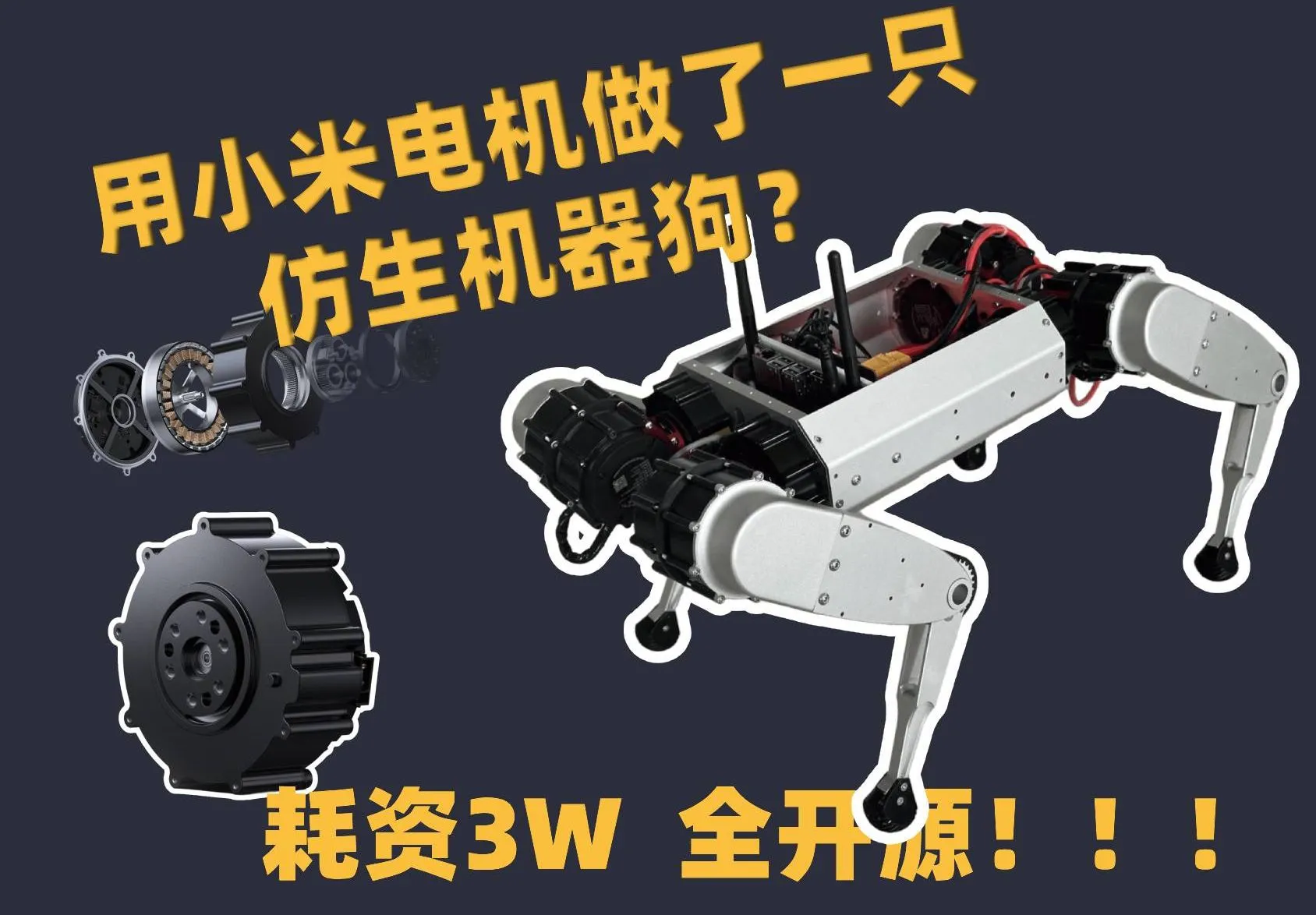 Completed
CompletedWangcai - Bionic four-legged robot dog
PRO Wangcai - Bionic four-legged robot dog
Wangcai - Bionic four-legged robot dog
License
:GPL 3.0
Description
Project Description
The aim of this project is to independently develop a high-performance robot dog with the ability to move freely in three-dimensional space. With a weight of 10 kg and an arm span of about 100 cm, the robot dog uses a servo brushless motor to control the joint movement and achieve efficient control through CAN communication.
Stacking shield (done in the third year,Some details of the project are not perfect.,Big guys tap and spray.,I'm still a child.,Please also ask for a like and collection)

Connect the umbilical cord to the power supply to adjust the attempt.
Hardware design
- Power system: Each leg is equipped with three motors to ensure flexible movement of the leg in three-dimensional space. The knee motor is designed by a synchronous belt to reduce energy loss during exercise.
- Control system:
- Upper computer: NVIDIA Orin NX high-performance computer to support high-computing power applications.
- Lower computer: It is composed of two STM32H7 single-chip microcontrollers, which communicate with the upper computer through SPI respectively, analyze instructions and control the motor.
- Power management: Realize 24V-19V, 19V-5V and 5V-3.3V three buck switch step-down and voltage stabilization circuits, and the on-load ripple is within 30mV.
- Communication: Four CAN buses achieve a communication rate of 1Mbps, and the SPI bus supports a speed of 16Mbps to ensure efficient and stable data transmission.
Software systems
- Control program: The host computer implements the underlying SPI transmitter program and gait planner, and at the same time develops the Xiaomi motor drive library, which supports control through ROS or C++.
- IoT integration: Through the MQTT protocol, the sensor data of the robot dog is uploaded to the IoT platform and visualized on the web to enhance the user experience.
Mechanical design
- Component design: A total of 79 parts and 276 bolt holes (incomplete statistics) were designed, which have been verified by more than 100 times of 3D printing to ensure the feasibility and stability of the design.
- Material selection: Finally, CNC machined aluminum alloy parts are used for assembly to improve the structural strength and durability of the robot dog.
Open-source protocol
Description of the open source agreement.
Project-related features
Main configurations:
- 12 degrees of freedom, servo brushless joint motor (Xiaomi micro motor)
- ORIN NX 16GB on-board computer.
- The lower computer STM32H750.
Functions:
Several bionic gaits, with a common interface that can be coupled with LiDAR and depth camera.
Project properties
This project is the first public and is my original project. The project has not won an award in another competition.
System Architecture:
It is mainly composed of upper computer, lower computer, motor and mechanical structure.
The lower computer system is composed of two STM32H7 and peripheral circuits to achieve three-level synchronous step-down circuit, two SPI buses, four CAN buses, and 12 joint servo motors are mounted respectively.
The lower computer and the upper computer use the SPI protocol for high-speed communication to meet the requirements of high-real-time and high-frequency motion control and attitude monitoring communication.
The host computer system consists of JETSON-ORIN NX and external devices, which realize attitude analysis and control, laser SLAM, environmental modeling, autonomous motion and navigation.
Mechanical Structure:
The mechanical structure consists of four mechanical legs, the main body of the robot, and the internal and external equipment fixing frames.
The following will explain the design of the mechanical leg in detail:
The mechanical leg is composed of three joint motors and a transmission structure, and the three joint motors are integrated at the hip joint through the transmission structure to reduce the movement inertia.
The overall structure is as follows:

The specific structure BOOM diagram (this diagram is generated from the first version of the structure, but only part of the dimensions have been changed in the later stage, and the overall structure has not changed):

The overall structure of the robot dog:

Lower computer system
- It is connected to the host computer through the 40PIN cable, and can be fixed in the hole position of the host computer through the M3 copper pillar.
- The main control is two STM32H750RCT6.
- Four CAN buses are mounted, and each CAN is equipped with three servo joint motors, a total of 12, and the maximum baud rate is 1M.
- Two SPIs, respectively responsible for the communication between each single-chip microcomputer and the host computer, the maximum baud rate is 15M.
- Onboard MPU6050 gyroscope.
- Three DC-DC synchronous step-downs, 24V-19V, 19V-5V, and 5V-3.3V, respectively. 19V is the power supply for the robot dog host computer ORIN NX (XT30), and 5V and 3.3V are for the single-chip microcomputer system.
- At the same time, it is integrated with a distribution board, which can provide four 24V XT60 interfaces and one 24V XT30 interface.
The main components are as follows:

Software Description
Tip: The software can be nested using code blocks, and there is no need to explain all the software parts, only the important parts.
Physical display
Upper and lower computer combination diagram.


Run, tune attempt

Mechanical assembly drawing

Shady Crawling & Neat Workbench:

Small steps, finally ready to go!!

Plastic to iron, glue to welding, the complete body is coming.

There is also an exclusive mark gesture!!

Other
Mechanical file: I shared the link to the "Robot Dog Mechanical File .rar" with Quark network disk: https://pan.quark.cn/s/6a68fb8ff5b8
MCU program: DOG_01, see the attachment for details.
Upper computer program: DOG_CTRL, see the attachment for details.
Designed by 有大饼的魔法少女 (from OSHWHub)
Link:https://oshwhub.com/gulu666/detector-disaster-scene-3d-reconstruction-robot-dog
Design Drawing
 The preview image was not generated, please save it again in the editor.
The preview image was not generated, please save it again in the editor. Empty
Empty


Comment